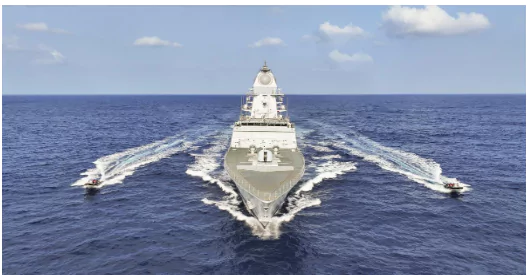The Indian Navy recently received INS Udaygiri, the second stealth frigate of Project 17A, delivered in a record time of 37 months, strengthening India’s naval capabilities.
About Project 17A
- Project 17A (P-17A) is an advanced shipbuilding initiative of the Indian Navy launched in 2019 as a successor to the Project 17 (Shivalik Class) frigates.
- Objective: To build stealth guided-missile frigates with improved stealth features, state-of-the-art weapons, advanced sensors, and sophisticated platform management systems.
- Construction Units: Mazagon Dock Shipbuilders Limited (MDL) and Garden Reach Shipbuilders & Engineers (GRSE) are building these frigates.
- Under the program, MDL is constructing four ships and GRSE is building three.
- First Ship: INS Nilgiri, launched in 2019, was the first stealth frigate under Project 17A.
- Significance : It highlights India’s increasing self-reliance in shipbuilding and is a major step toward achieving an indigenously designed modern naval fleet.
|
About Stealth Frigate
A stealth frigate is a modern naval warship designed to evade enemy detection by minimizing various signatures.
- Radar Cross-Section Reduction: Stealth frigates have specially designed hulls and superstructures that deflect and absorb radar waves, reducing their radar visibility.
- Signature Management: These ships use advanced technologies to manage electromagnetic emissions, minimizing detection by enemy electronic sensors.Low Infrared and Acoustic Signatures: Stealth frigates employ thermal masking materials and sound-reducing designs to lower infrared and acoustic footprints, making them harder to detect by heat-seeking and sonar systems.
- Multi-role Capability: Stealth frigates are equipped for anti-submarine, anti-air, maritime patrol, and escort missions, offering strategic flexibility in modern naval warfare.
About Udaygiri Frigate
- Udaygiri is the modern avatar of the erstwhile INS Udaygiri (a steam-powered ship decommissioned in 2007).
Key Features
- Enhanced Stealth: Superior radar, thermal, and acoustic signature reduction.
 State-of-the-Art Systems: Fitted with advanced weapons, sensors, and modern warfare technologies.
State-of-the-Art Systems: Fitted with advanced weapons, sensors, and modern warfare technologies.- Multi-Mission Capability: Can counter both conventional and non-conventional threats across maritime domains.
Significance of Udaygiri
- Boost to Maritime Security: Enhances India’s blue-water naval operations and maritime dominance.
- Symbol of Atmanirbhar Bharat: Demonstrates India’s growing indigenous capabilities in advanced naval ship design and construction.
- Engineering Excellence: Reflects the progress of Indian shipyards in delivering complex warships within stringent timelines.
- Strategic Value: Adds significant strength to the Indian Navy’s surface fleet in an increasingly contested Indo-Pacific region.
- Industrial Collaboration: Supported by over 200 Indian MSMEs, reflecting the strength of India’s defence industrial base.
Blue Water Naval Force
- Navies are broadly classified as Brown Water (coastal), Green Water (regional), and Blue Water (global reach).
- A Blue Water Navy is a naval force capable of operating in the deep oceans, far beyond its country’s maritime borders, without needing to return to home ports for resupply.
- According to the Indian Maritime Doctrine (2015), such navies require strong logistics, surveillance, and the ability to sustain distant operations independently.
- Blue Water Navies can project power globally, ensure maritime security, protect trade routes, and support national interests across distant oceans.
- Countries like the United States, China, and India possess Blue Water capabilities.
- India’s Navy, with aircraft carriers and long-range operational capacity, is recognized as a Blue Water Force.
|
![]() 2 Jul 2025
2 Jul 2025

 State-of-the-Art Systems: Fitted with advanced weapons, sensors, and modern warfare technologies.
State-of-the-Art Systems: Fitted with advanced weapons, sensors, and modern warfare technologies.